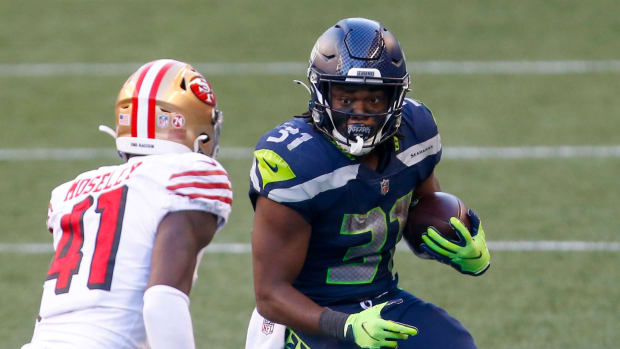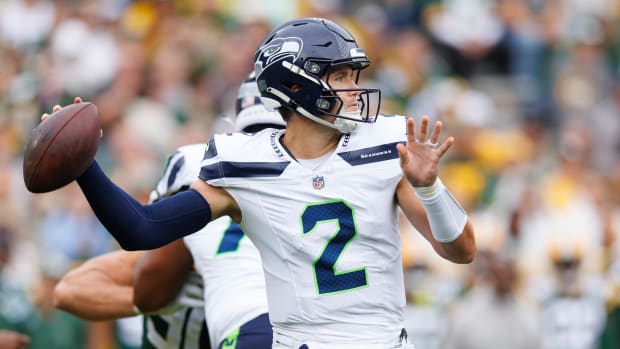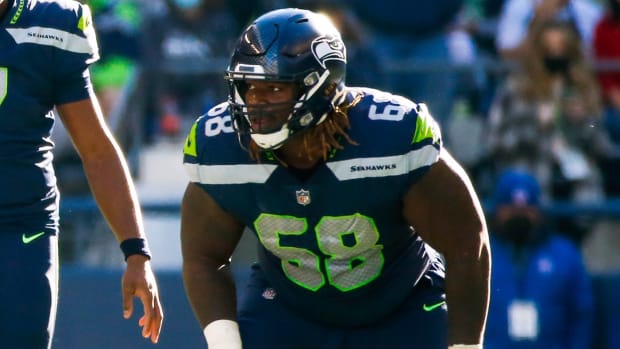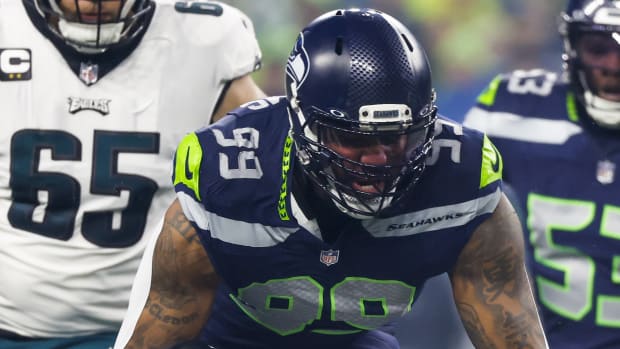Clint Hurtt's Seahawks Defense Represents Fundamental Change by Pete Carroll
One constant has been true in Seattle from 2010: It’s Pete Carroll’s defense. The Seahawks head coach has leaned on his defensive background of coaching since 1973, employing a shade defense Carroll has attributed to his mentor Monte Kiffin.
Until—seemingly—now.
The comments of new defensive coordinator Clint Hurtt this week suggest that the Seahawks' defense is undergoing foundational change for the first time since Carroll landed in the Pacific Northwest. Hurtt, associate head coach Sean Desai and defensive pass game coordinator Karl Scott are going to lead a new era of Seattle defense.
Speaking to Dave Wyman and Bob Stelton on 710 ESPN Seattle, Hurtt pushed back against the idea that Carroll dictates.
“I think that’s way overblown, in what’s being said,” Hurtt stated. “Pete is the type of coach, he’s gonna let you coach. And how you run things and you call it, any head coach—when that side of the ball is his expertise—he’s going to talk you through some things because he’s been through it before. You know, obviously, he’s the architect of the defense that was here, that went to two Super Bowls and won a ton of games and played great defense for a long time.
“But the one thing about Pete is he has the ability to do what is going on now, you gotta be able to turn the page. When there’s a time for things to adjust and adapt, you know Pete is going to do that. And that’s one of the very first comments he made to me was like: ‘Listen, I’m not hanging on to what we’ve done in the past. If things marry in to what we wanna do going forward, then we can do that.’ But he said: ‘I wanna grow and evolve.’ He said: ‘I know you have done different things in your career.’"
This is an encouraging acknowledgement of the time-proved “adapt or die" mentality, although the implication of Carroll saying “what we wanna do going forward, then we can do that” is still of his guidance. That’s no bad thing, of course.
“I want to also lean on him for his expertise. This guy’s been in here for a long time and won a lot of games,” Hurtt recognized. “To me, Pete being involved and knowing everything that’s going on, to me that’s a resource, that’s not an issue like some people would try to make that come across.”
Yet beyond the schematic Darwinism, there came real juicy detail of defensive coach empowerment we have not seen from the Seahawks. Hurtt said he had been given “full autonomy” by Carroll, later finishing with: “He’s given us full reign to go and put in defense, run it. It’s not the things that we’ve always been running here for the last, you know, 11, 12 years.”
Autonomy does not necessarily suggest Hurtt and his staff are the ones devising the root of the scheme. “Full reign to go and put in defense” is more certain. And the “last 11, 12 years” part? It sounds like a completely new system is landing in Seattle.
Indeed, when Hurtt was questioned on his first tasks, his answer once more included a lot of shifting that went beyond Carroll-led stuff.
“A lot of it is us [new coaches] getting on the same page terminology-wise. You know how we're gonna continue to call offensive formations. Then we have to build the defensive playbook because it's changing. So how we call fronts, how we call stunts and games, the coverage system and how we're doing that. And the terminology that we'll use for different techniques. So there's a lot we're super busy with right now. We're putting all those things together so that we're all on the same page."
Carroll’s 2021 Seahawks defense was using the same language and concepts as his 2001 USC defense. A defensive playbook will naturally undergo slight change each year. Yet the Seahawks used largely the same names for their fronts, stunts, games, coverage system and techniques as Carroll did since forever. The new Hurtt-Desai-Scott triumvirate having the authority to overwrite this is a seismic moment in franchise history. All the evidence points towards a huge 2022 playbook transformation.
Hurtt’s radio hit came after he had explained to reporters the solution to the challenges the old scheme experienced.
“Sometimes that means you have to adjust your scheme,” Hurtt revealed on February 16. “And that’s where we have, we are going into a transition of right now. It’s starting to—we’re learning and adapting from where we’ve been, obviously, with my background, Sean, Karl Scott, the new guys that have come in here. We’re adjusting and some things are gonna be changing.”
Hurtt correcting his transition statement from “where we have” to “we are going into” is a reflection of the schematic amendments that were already occurring on the defense in past seasons. Key examples would be the bear front-heavy usage that commenced in 2020, the bonus fire zones and the CLEO, half-quarter-quarter zone-match coverage that emerged in 2021. These concepts are similar to those of Vic Fangio and Nick Saban, to the backgrounds of Desai and Scott.
Combining Hurtt’s comments with his 710 ESPN Seattle appearance confirms that the coaches will be given a ton of creative license and that, when Hurtt said “some things are gonna be changing,” the shaping will be a much more free-of-Carroll endeavor than we initially anticipated.
This is not an alien situation for the 70-year old Carroll. When he arrived in Seattle, the blossoming of the Cover 3-heavy system was a coach-led initiative. After a 2010 season where the Seahawks ran a ton of different defenses, Seattle’s staff honed in on fewer coverages and fronts. Gus Bradley—not Carroll—was instrumental in devising the vision-and-break Cover 3 rules, along with the indicators that turned the spot-drop underneath landmarks into more matching principles.
Like 2011, it seems 2022 is a moment of a new, young coaching staff coming together to create a defense. However, it looks like 2022 will take this evolution way beyond where Carroll has been, going past technique and coverage focus to alter the very roots of the system.
“As head coach, I set the vision and philosophy, but it is the coordinators and other coaches who are charged with implementing it on the ground with the players every day,” the head coach wrote in his 2010 book Win Forever. In 2022, Clint Hurtt appears to have a much larger say on vision and philosophy than any defensive coach who has worked under Carroll before.
Or, rather than Carroll being relentlessly adherent to his system, the past few years were more a case of Ken Norton Jr. running a defense that stuck to his own schematic experience in Carroll defenses. This coming season will be the first year that the Seahawks are without a coach from the Carroll USC era. To see how far this 2022 Seattle re-styling goes, we must wait for more press conferences, next season’s games and, of course, new high-quality snaps of play sheets.





